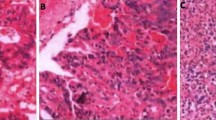Abstract
Little is known about the relationship about Helicobacter pylori (H. pylori) infection and pancreatic, and this study was set to investigate how H. pylori infection is correlated with pancreatic cancer and provide references for the clinical prevention and treatment of pancreatic cancer. 56 cases of pancreatic cancer patients admitted to the hospital from August 2012 to August 2013 were collected as the observation group. The anti-Hp IgG (H. pylori-specific antibodies), Hp IgM (H. pylori antibodies), and CagA-Hp-IgG (H. pylori serotoxin-associated protein a antibody) in the serum were measured and compared with the related indicators of control group (60 cases of healthy subjects). The H. pylori infection rate was 64.29 % in the observation group, and that in the control group was 46.67 %. Our results showed that the H. pylori infection rate in the observation group was significantly higher than that in the control group, which was statistically different (P < 0.01). The positive rate of CagA-Hp in the observation group was 38.88, and 21.53 % in the control group, for which the observation group was significantly higher than the control group (P < 0.05). The occurrence of H. pylori infection in patients with pancreatic cancer was also positively correlated with the smoking history and the history of chronic pancreatitis (P < 0.05). Helicobacter pylori infection is one of the risk factors for pancreatic cancer, and the patients with positive CagA-Hp have the higher risk, so the prevention and treatment of H. pylori infection would be beneficial for the prevention and treatment of pancreatic cancer.
Similar content being viewed by others
References
Xu, P., Huang, Q., Liu, C. H., et al. (2011). Risk factors for pancreatic cancer: A case–control study. Tumor, 31(7), 653–657.
Dou, Y. C., & Wang, J. B. (2008). Detection of H. pylori infection in patients with pancreatic cancer and clinical significance. Journal of Jilin University (Medicine Edition), 34(2), 317–319.
Hidalgo, M. (2010). Pancreatic cancer. New England Journal of Medicine, 362, 1605–1617.
Hassan, M. M., Bondy, M. L., Wolff, R. A., Abbruzzese, J. L., Vauthey, J. N., et al. (2007). Risk factors for pancreatic cancer: Case–control study. American Journal of Gastroenterology, 102, 2696–2707.
Lowenfels, A. B., & Maisonneuve, P. (2002). Epidemiologic and etiologic factors of pancreatic cancer. Hematology/Oncology Clinics of North America, 16, 1–16.
Kang, R., & Tang, D. (2012). Autophagy in pancreatic cancer pathogenesis and treatment. American Journal of Cancer Research, 2, 383–396.
Raimondi, S., Maisonneuve, P., & Lowenfels, A. B. (2009). Epidemiology of pancreatic cancer: An overview. Nature Reviews Gastroenterology and Hepatology, 6, 699–708.
Wu, C., Miao, X., Huang, L., Che, X., Jiang, G., et al. (2012). Genome-wide association study identifies five loci associated with susceptibility to pancreatic cancer in Chinese populations. Nature Genetics, 44, 62–66.
Zhang, X., Zhong, R., Zhang, Z., Yuan, J., Liu, L., et al. (2011). Interaction of cyclooxygenase-2 promoter polymorphisms with Helicobacter pylori infection and risk of gastric cancer. Molecular Carcinogenesis, 50, 876–883.
Trikudanathan, G., Philip, A., Dasanu, C. A., & Baker, W. L. (2011). Association between Helicobacter pylori infection and pancreatic cancer. A cumulative meta-analysis. JOP, 12(1), 26–31.
Raderer, M., Wrba, F., Kornek, G., Maca, T., Koller, D. Y., Weinlaender, G., et al. (1998). Association between Helicobacter pylori infection and pancreatic cancer. Oncology, 55, 16–19.
Stolzenberg-Solomon, R. Z., Blaser, M. J., Limburg, P. J., Perez-Perez, G., Taylor, P. R., Virtamo, J., et al. (2001). Helicobacter pylori seropositivity as a risk factor for pancreatic cancer. Journal of the National Cancer Institute, 93, 937–941.
Lindkvist, B., Johansen, D., Borgström, A., & Manjer, J. (2008). A prospective study of Helicobacter pylori in relation to the risk for pancreatic cancer. BMC Cancer, 8, 321.
de Martel, C., Llosa, A. E., Friedman, G. D., Vogelman, J. H., Orentreich, N., Stolzenberg-Solomon, R. Z., et al. (2008). Helicobacter pylori infection and development of pancreatic cancer. Cancer Epidemiol Biomarkers Prevention, 17, 1188–1194.
Risch, H. A., Yu, H., Lu, L., & Kidd, M. S. (2010). ABO blood group, Helicobacter pylori seropositivity, and risk of pancreatic cancer: A case–control study. Journal of the National Cancer Institute, 102, 502–505.
Wadstrom, T., Fryzek, J. P., Demirjian, S., Choi, J. W., Garabrant, D. H., Nyren, O., et al. (2004). Antibodies to Helicobacter bills in patients with pancreatic carcinoma. Helicobacter, 9, 538.
Jesnowski, R., Isaksson, B., Möhrcke, C., Bertsch, C., Bulajic, M., Schneider-Brachert, W., et al. (2010). Helicobacter pylori in autoimmune pancreatitis and pancreatic carcinoma. Pancreatology, 4, 462–466.
Nakayama, M., Iwakiri, R., Hara, M., Ootani, H., Shimoda, R., Tsunada, S., et al. (2009). Low-dose aspirin is a prominent cause of bleeding ulcers in patients who underwent emergency endoscopy. Journal of Gastroenterology, 44(9), 912–918.
Wang, G. Y., Huang, X. H., & Wu, G. P. (2009). Influence of Helicobacter pylori infection on serum IL-6, IL-8 and NO in duodenal ulcer patients. Journal of Hainan Medical College, 15(8), 45–47.
Tang, J. H., & Lv, N. H. (2008). A study on the relationship of Helicobacter pylori and vitamin C to gastric mucosa lesions. Chinese Journal of Postgraduates of Medicine, 31(10), 23–25.
Shimizu, S., Nakamura, S., Kishino, M., Konishi, H., & Shiratori, K. (2009). Role of antithrombotic therapy and nonsteroidal anti-inflammatory drug use in bleeding gastroduodenal ulcers. Internal Medicine, 48(9), 631–637.
Lee, S. W., Chang, C. S., Lee, T. Y., Yeh, H. Z., Tung, C. F., & Peng, Y. C. (2010). Risk factors and therapeutic response in Chinese patients with peptic ulcer disease. World Journal of Gastroenterology, 16(16), 2017–2022.
Sokic-Milutinovic, A., Krstic, M., Rozer-Smolovic, B., & Alempijevic, T. (2010). Role of Helicobacter pylori infection in gastroduodenal damage in patients starting NSAID therapy: 4 Months follow-up study. Digestive Diseases and Sciences, 55(10), 2887–2892.
Author information
Authors and Affiliations
Corresponding author
Rights and permissions
About this article
Cite this article
Ai, F., Hua, X., Liu, Y. et al. Preliminary Study of Pancreatic Cancer Associated with Helicobacter pylori Infection. Cell Biochem Biophys 71, 397–400 (2015). https://doi.org/10.1007/s12013-014-0211-2
Published:
Issue Date:
DOI: https://doi.org/10.1007/s12013-014-0211-2




